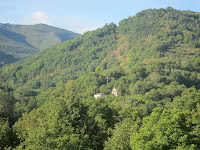An earlyish start to walk 25 km steadily
uphill to a few km past the iron cross at 1530 m. The very best tortilla ever
for lunch. Pilgrims leave a stone at its base to represent their leaving their
sin behind. From here, the body heals and the soul heals on completion at
Santiago. From the ancient cross, the
terrain slopes gradually back down towards the rolling plateau we had driven
across. To the east, the landscape suddenly changes to steep slopes and deep
gorges.
 We overnighted at a modern hotel that caters for weddings from the
nearby wealthy looking industrial town. Love
is in the air in spluttering neon lights up the lawn and for the first
time, we taste the Murcian wine of Galicia. Until the freeway tunnels and
viaducts were constructed, this narrow road was the main connection between
Galicia and the rest of Spain. Most Galicians seeking a new life, therefore
sailed to America rather than crossing into Spain
We overnighted at a modern hotel that caters for weddings from the
nearby wealthy looking industrial town. Love
is in the air in spluttering neon lights up the lawn and for the first
time, we taste the Murcian wine of Galicia. Until the freeway tunnels and
viaducts were constructed, this narrow road was the main connection between
Galicia and the rest of Spain. Most Galicians seeking a new life, therefore
sailed to America rather than crossing into Spain
The next day we are driven across
industrial Ponferrad and up along narrowing gorges to start our ascent of 700m
over about 12km. Ponferrad has a small, very defensible Templar castle, now a
private house, with (almost) a drawbridge and plenty of places for shooting
intruders.
 We started walking at a tiny village with huge viaducts high above
us. The track rose steadily and, while my legs are now good enough, my
cardiovascular system insisted on regular stops. Our hostel accommodation was in
O’Cerbriero at 1400 m. The village was becoming derelict until taken in hand by
the local priest, who has many memorials near the simple reconstructed church.
A couple of gift shops, but lots of rooms for rent and places to eat for the
pilgrims. The old circular thatched stone houses have been kept – tight
accommodation for an extended family and their animals. They stayed warm in a
long winter by the animals down below and a fire with no smoke outlet in the
living area. The mist had rolled in and everything was cold and damp when we
came out of mass.
We started walking at a tiny village with huge viaducts high above
us. The track rose steadily and, while my legs are now good enough, my
cardiovascular system insisted on regular stops. Our hostel accommodation was in
O’Cerbriero at 1400 m. The village was becoming derelict until taken in hand by
the local priest, who has many memorials near the simple reconstructed church.
A couple of gift shops, but lots of rooms for rent and places to eat for the
pilgrims. The old circular thatched stone houses have been kept – tight
accommodation for an extended family and their animals. They stayed warm in a
long winter by the animals down below and a fire with no smoke outlet in the
living area. The mist had rolled in and everything was cold and damp when we
came out of mass.
Drizzling mist for the fist half of our
next walk down to Triacastella at 620m. The poor villages along the route only
have old people and a few cattle. The first half of the walk was along a ridge
in the mist before we plunged down to a delightful lunch just before the
destination. The waitress said that the high season for Spanish walkers is July
and August, but there were very few this year. They were replaced by many
Americans who had seen The Way and
many Koreans who have a camino-inspired walk in their own country. We were
welcomed to Triacastella by a Cuban music jam session – fantastic! The night
was in a renovated rural rectory, one of about 80 scattered across Galicia,
advertising a rural gourmet experience



No comments:
Post a Comment